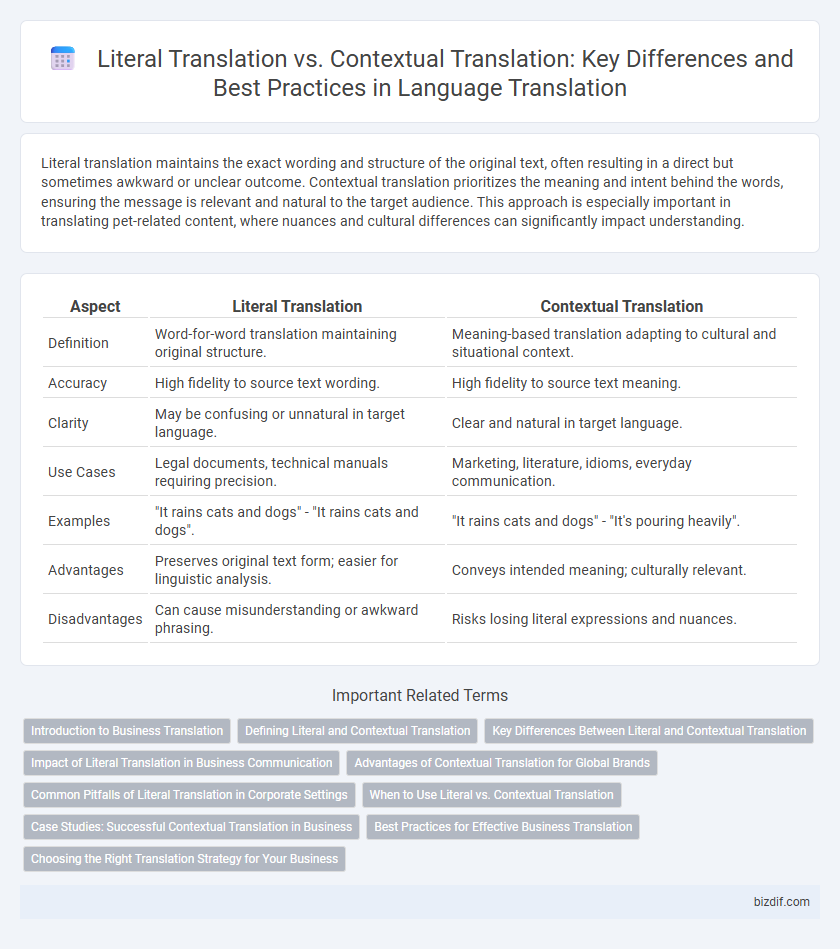Literal translation maintains the exact wording and structure of the original text, often resulting in a direct but sometimes awkward or unclear outcome. Contextual translation prioritizes the meaning and intent behind the words, ensuring the message is relevant and natural to the target audience. This approach is especially important in translating pet-related content, where nuances and cultural differences can significantly impact understanding.
Table of Comparison
| Aspect | Literal Translation | Contextual Translation |
|---|---|---|
| Definition | Word-for-word translation maintaining original structure. | Meaning-based translation adapting to cultural and situational context. |
| Accuracy | High fidelity to source text wording. | High fidelity to source text meaning. |
| Clarity | May be confusing or unnatural in target language. | Clear and natural in target language. |
| Use Cases | Legal documents, technical manuals requiring precision. | Marketing, literature, idioms, everyday communication. |
| Examples | "It rains cats and dogs" - "It rains cats and dogs". | "It rains cats and dogs" - "It's pouring heavily". |
| Advantages | Preserves original text form; easier for linguistic analysis. | Conveys intended meaning; culturally relevant. |
| Disadvantages | Can cause misunderstanding or awkward phrasing. | Risks losing literal expressions and nuances. |
Introduction to Business Translation
Literal translation in business contexts often leads to misinterpretation of critical terms, affecting contract clarity and corporate communications. Contextual translation prioritizes meaning and cultural nuances, ensuring that financial reports, marketing materials, and legal documents resonate accurately with the target audience. Effective business translation balances literal accuracy with contextual relevance to uphold professionalism and foster international partnerships.
Defining Literal and Contextual Translation
Literal translation focuses on word-for-word accuracy, preserving the exact wording and structure of the source text to maintain fidelity. Contextual translation prioritizes conveying the intended meaning, cultural nuances, and idiomatic expressions, ensuring the message resonates appropriately in the target language. Both approaches serve distinct purposes, with literal translation suitable for technical or legal documents, while contextual translation excels in literature, marketing, and conversational content.
Key Differences Between Literal and Contextual Translation
Literal translation preserves the exact wording and structure of the source text, often resulting in a direct but sometimes awkward or inaccurate rendering. Contextual translation prioritizes meaning and cultural nuances, adapting phrases to convey the intended message naturally in the target language. Key differences include fidelity to source text versus adaptability for readability, with literal translation focusing on word-for-word accuracy and contextual translation emphasizing sense-for-sense communication.
Impact of Literal Translation in Business Communication
Literal translation in business communication often leads to misunderstandings and misinterpretations as it fails to capture the intended meaning and cultural nuances. This can result in damaged professional relationships, loss of credibility, and ineffective messaging across international markets. Emphasizing contextual translation ensures that the business message resonates accurately with the target audience, preserving intent and fostering clearer communication.
Advantages of Contextual Translation for Global Brands
Contextual translation ensures that global brands communicate their message accurately across diverse cultures by capturing nuances and cultural references that literal translation often misses. This approach enhances brand perception and customer engagement by adapting content to local idioms, customs, and preferences. Brands leveraging contextual translation achieve greater market resonance and avoid misunderstandings that could damage their reputation internationally.
Common Pitfalls of Literal Translation in Corporate Settings
Literal translation in corporate settings often leads to miscommunication due to ignoring cultural nuances and industry-specific jargon, resulting in confusion among international stakeholders. Misinterpretation of idiomatic expressions and technical terms can damage brand reputation and hinder effective collaboration. Relying solely on word-for-word translation compromises the clarity and professionalism essential for successful business communications.
When to Use Literal vs. Contextual Translation
Literal translation is ideal for technical documents, manuals, or legal texts where exact wording and precision are critical to maintain the original meaning. Contextual translation works best in marketing materials, literature, or conversations where cultural nuances, idioms, and tone influence the message and emotional impact. Choosing between literal and contextual translation depends on the purpose of the text and the target audience's need for accuracy or relatability.
Case Studies: Successful Contextual Translation in Business
Case studies demonstrate that contextual translation enhances brand messaging accuracy and customer engagement by adapting content to cultural nuances rather than relying on literal translation. For example, global companies like Coca-Cola and Nike have successfully localized advertising campaigns through contextual translation, resulting in increased market penetration and consumer trust. These cases highlight the importance of cultural insight and contextual adaptation in business translation strategies for maintaining relevance and maximizing impact.
Best Practices for Effective Business Translation
Literal translation often fails to convey the intended meaning in business documents, leading to misunderstandings that can harm professional relationships. Contextual translation, which prioritizes cultural nuances and industry-specific terminology, ensures clarity and accuracy, fostering better communication and trust. Employing skilled translators who understand both source and target languages, as well as business contexts, is essential for effective translation outcomes.
Choosing the Right Translation Strategy for Your Business
Selecting the right translation strategy for your business depends on whether you prioritize accuracy or cultural relevance. Literal translation preserves the exact wording, essential for technical manuals and legal documents, while contextual translation adapts messages to resonate with target audiences, enhancing engagement and brand perception. Balancing these approaches ensures clear communication and effective localization tailored to market needs.
Literal Translation vs Contextual Translation Infographic

 bizdif.com
bizdif.com